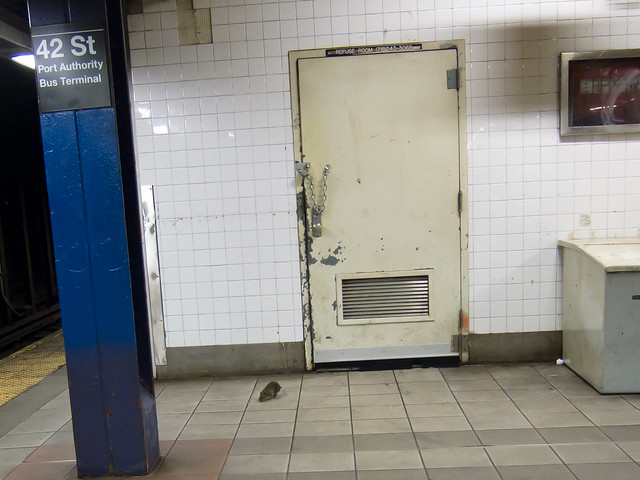As I wait for the subway at various stations and at various times, I often take a close look at my surroundings. I’m not looking for shady characters or suspicious packages. Rather, I look to see how the stations appear. With dirty or missing tiles, trash and the occasional pigeon, the platforms are often not much to look at. We have rats; we have garbage; we have things we’d rather not know about. But just how bad are they?
Yesterday, the Straphangers Campaign released its second annual State of the Subway Platform report, and there’s good news and bad news. The good news is that we still have subway platforms. No, wait. That’s not it. The good news is that subway platform conditions haven’t really degraded much since last year’s survey and that rat sightings may be down. The bad news is that subway platforms are still pretty gross.
“We applaud transit managers and workers for improving conditions at many stations,” Jason Chin-Fatt, a field organizer with the Straphangers who ran the survey said. “But there’s still room for further progress. There’s no reason, for example, that riders should have a one in ten chance of seeing a rat while waiting for a train.”
The survey — which took place at 251 stations between the end of May and the beginning of August last year — found that water damage and graffiti are on the rise while rat sightings have declined. There were fewer garbage bags on station platforms, and the Straphangers found fewer staircases in disrepair, less exposed wiring, a reduction in floor cracks, and better lighting. I believe that is a testament to the MTA’s component-based repair project which aims to fix the worst elements at stations rather than subjecting them to timely and costly rehabs.
While Transit conducts its own survey of stations, the Straphangers say they assess different variables. They did however offer up some ways in which their responses differ from the MTA’s assessment:
- Our finding — that, in the summer of 2012, 98% of the observed platforms had a garbage can and that only 1% of these were overflowing — is similar to the relevant PES measure. For the first half of 2012, NYC Transit found 98% of “trash receptacles usable in stations;” and
NYC Transit PES found 100% of the stations had none or only “light” “graffiti conditions” in the first half of 2012. The Straphangers Campaign survey found substantial graffiti at 27% of all the platforms observed in the summer of 2012, which was worse than in 2011 (20%).
All of this is well and good, but let me pose a question: How do you feel about the station platforms? I don’t feel too good about them, and I know I’m not alone. A friend of mine recently spoke about how dirty he felt platforms had become over the last few years, and during the James Vacca-hosted complaint-fest earlier this week, a few City Council members expressed similar views.
When I look around station platforms, I see a state of neglect and disarray. Now, of course, it’s better today than it was two decades ago, but stations that were rehabbed ten years ago are showing their age. Meanwhile, those stations that haven’t been overhauled looked terrible. They’re dark, dingy and evidently unclean. Even those with a trash can or two are replete with litter.
I’ve always wondered if we should care. Station environments are only skin deep. I’d prefer to have new rolling stock, modern signals and speedier trains before stations get their dues. But at the same time, stations set the tone for the subway system. If stations look nicer, customers are more likely to treat the subways with respect. For now though the state of the platforms is good enough for the Straphangers. Perhaps we’re settling for too little though.














 (Overnights)
(Overnights)




 (42nd Street Shuttle) (Overnights)
(42nd Street Shuttle) (Overnights)